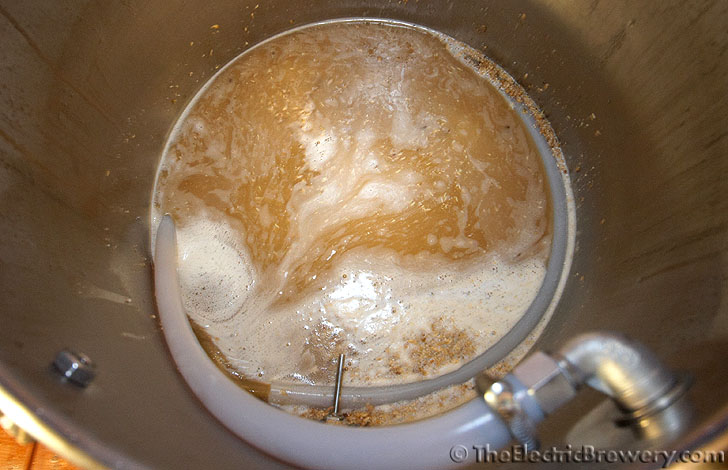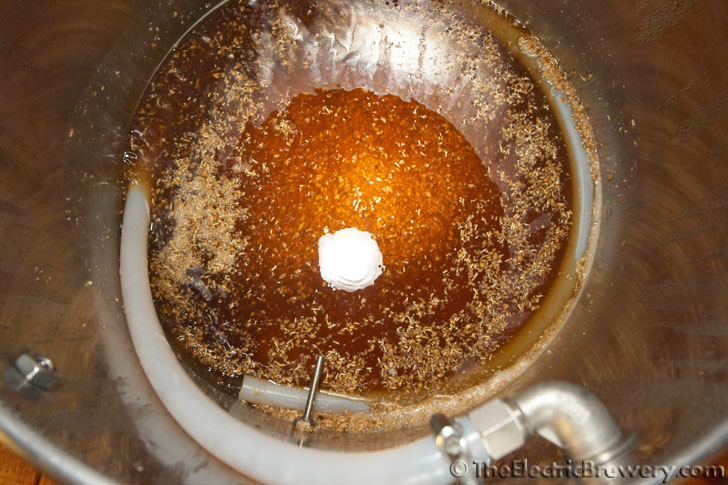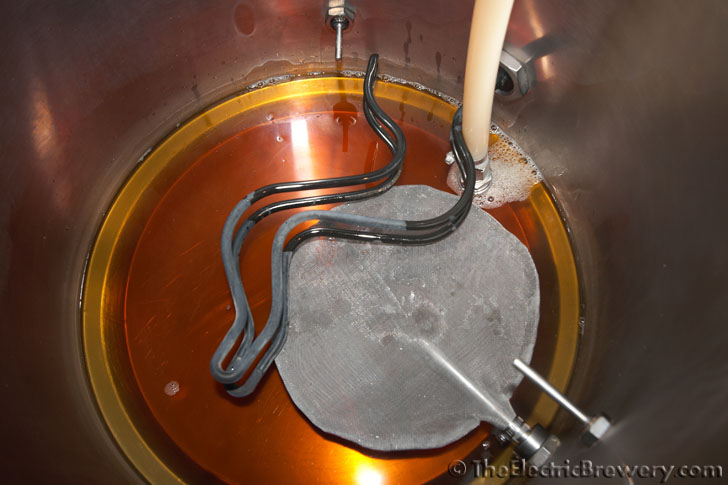You are using an out of date browser. It may not display this or other websites correctly.
You should upgrade or use an alternative browser.
You should upgrade or use an alternative browser.
How long do you run your RIMS/HERMS?
- Thread starter reuliss
- Start date

Help Support Homebrew Talk - Beer, Wine, Mead, & Cider Brewing Discussion Forum:
This site may earn a commission from merchant affiliate
links, including eBay, Amazon, and others.
When I was using a single element RIMS I would cycle power to limit the amount of "gunk" on the element. Also cuts down on scorching those delicate beers. I now have 2 RIMS in series and will turn off 1 of them when I'm at temp.
I've never heard of anybody doing that. What's the motivation behind the question? Is this something you are thinking about doing? If so what are your reasons for doing so?
I've never heard of anybody doing that. What's the motivation behind the question? Is this something you are thinking about doing? If so what are your reasons for doing so?
I'm asking only because I've been running mine the entire 60 minutes and have just assumed that doing so makes the most sense, especially in order to maintain temps. But I've been dealing with some astringency issues, and in trying to narrow down the causes, I've wondered if recirculating the entire time has contributed/caused my issue.
kal
Well-Known Member
I run mine for 90-120 minutes to sometimes even 3 hours.
Astringency issues would be elsewhere.
Kal
Astringency issues would be elsewhere.
Kal
novahokie09
Well-Known Member
Main culprits of astringency would be sparge pH, grain crush and sparge temperature.
Also, are you getting any grains into the boil kettle?
Also, are you getting any grains into the boil kettle?
I run mine the full mash. It is controlled by a PID and one it reaches temp, it just flickers off and on. The one thing I have changed is I now place my probe directly into the mash instead of the the thermowell that is inserted into my RIMS tube. The temp diff was as much as 8-degrees cooler when I used the thermowell. So bringing the temp up to say 150 in the thermowell resulted in actual mash temp that could be 8-degrees higher and that is verified with a Thermapen.
Now before everyone goes nuts, I'll explain a little more. I use an Auber Sous Vide PID controller. It has a small probe that is meant to be immersed in liquid and I'm sure that is why it is not so accurate when inserted into the thermowell.
Now before everyone goes nuts, I'll explain a little more. I use an Auber Sous Vide PID controller. It has a small probe that is meant to be immersed in liquid and I'm sure that is why it is not so accurate when inserted into the thermowell.
kal
Well-Known Member
Another reasons to recirculate the full time is that you're basically vorlaufing (filtering) for the entire duration. The wort by the end is crystal clear.
Cloudy at the start:

After an hour or so:

When sparging into the boil kettle it's crystal clear:

Kal
Cloudy at the start:

After an hour or so:

When sparging into the boil kettle it's crystal clear:

Kal
Bensiff
Well-Known Member
- Joined
- Mar 13, 2008
- Messages
- 4,835
- Reaction score
- 411
The only part I don't run the herms is after mashing in while I get the HLT topped up and the temp adjusted. As Kal said, the constant running is a vorlauf. As you see in Kals pictures the wort is clear, that is what it should look like if the vorlauf is done properly. Most home brewers do not do it properly and transfer cloudy wort after only cycling a few quarts or gallons.
Anyway, as for astringency, your most likely culprit is pH. You can boil grains and not get astringency if the pH is in the proper range. If your pH is high you can extract astringent tannins at normal mash temps.
Anyway, as for astringency, your most likely culprit is pH. You can boil grains and not get astringency if the pH is in the proper range. If your pH is high you can extract astringent tannins at normal mash temps.
Not to hijack, but I'm setting a HERMS and have a similar question. If my Herms is in the HLT do I need to circulate or stir the water in the HLT while I run my HERMS? This is an electric system and I figure I would get a more uniform temp in the HTL if I do.
Bensiff
Well-Known Member
- Joined
- Mar 13, 2008
- Messages
- 4,835
- Reaction score
- 411
Not to hijack, but I'm setting a HERMS and have a similar question. If my Herms is in the HLT do I need to circulate or stir the water in the HLT while I run my HERMS? This is an electric system and I figure I would get a more uniform temp in the HTL if I do.
It would help to keep the temp equal throughout the entire HLT so that allows the element to be controlled more accurately. Otherwise the temp probe may be reading differently than what the water temp is around the herms coil.
kal
Well-Known Member
+1. You need to recirc to avoid the stratification you'll get. You won't be able to hold a constant temp otherwise.It would help to keep the temp equal throughout the entire HLT so that allows the element to be controlled more accurately. Otherwise the temp probe may be reading differently than what the water temp is around the herms coil.
Why?I run an electric RIMS and when I mash in I allow the grain to rest for approx 10 minutes before I begin to recirculate.
Kal
I turn mine on like 8 hrs before I mash in to heat up my water, then run it the entire mash.
50$ HERMS System
50$ HERMS System
byrone
Well-Known Member
- Joined
- Jan 25, 2013
- Messages
- 100
- Reaction score
- 5
It's just part of my process. I don't begin to recirculate until I take my first ph reading and it's in the range that I want. As long as I hit my target temperature(measured at different depths) I don't feel a need to begin recirculating any earlier. This is just the way that I do it.
It's just part of my process. I don't begin to recirculate until I take my first ph reading and it's in the range that I want. As long as I hit my target temperature(measured at different depths) I don't feel a need to begin recirculating any earlier. This is just the way that I do it.
Same here...I am doing other stuff at this time like getting strike water ready, so it takes me about 10 minutes to get the RIMS fired up and running. I use NG instead of electricity, though that is really appealing to me and may be my eventual setup. Anyhow, I think this allows the grain bed to settle a bit so I have fewer fine particles recirculating as a bonus. I don't time it per se, it just works out that it takes me 10 minutes or so, with my rig, to get things settled and then get to auto tuning the PID and recirculating. I then run it for the entirety of the mash. I mash for 90 minutes out of habit (good or bad...) so I am running the RIMS for 80 or so minutes. I overshoot the beersmith recommended temp by a few degrees and I am usually spot on the desired mash temp when the RIMS starts up. Like Kal says, this is like a very long vorlauf and after a bit the wort is crystal clear and at proper mash temps. I am super happy with this setup as it allows me to control a critical part of brewing, mash temps. Almost as critical as fermentation temp!
Not to hijack, but I'm setting a HERMS and have a similar question. If my Herms is in the HLT do I need to circulate or stir the water in the HLT while I run my HERMS? This is an electric system and I figure I would get a more uniform temp in the HTL if I do.
When I first started to build my HERMES I did try without recirculation and It worked ok. It depends on where you meassure the temperature and where the heater is located compared to the coil. I only lost about 2F from the HLT setpoint to the coil out temp, so it was not that bad. Today I use a second pump and recirculates the water through my external hx (for heat sanitation) back into the HLT. Since I have a flat setup, I need the extra pump anyway.
Sent from my iPhone using Home Brew
wbarber69
Well-Known Member
- Joined
- Oct 13, 2013
- Messages
- 2,191
- Reaction score
- 263
I use 2 us solar pumps 1 recirculates mash and the other reciculates the water in my HLT. 2 of them cost what 1 march pump does. And after running up and out 25' of coil the flow is slow enough that barely have to throttle my mash pump. The HLT pump runs all the time. To avoid stratification.
kal
Well-Known Member
I actually do exactly the same... there's about a 10 min rest between the time I mash in, stir in my salts well, take pH readings, adjust if required, re-read. Then recirc starts.It's just part of my process. I don't begin to recirculate until I take my first ph reading and it's in the range that I want. As long as I hit my target temperature(measured at different depths) I don't feel a need to begin recirculating any earlier. This is just the way that I do it.
Sorry - my confusion. The way you wrote it made it sound like there was a specific reason you wanted to wait 10 mins, not that it takes 10 mins before you can start recirc (ie: you can't really start any earlier).
Kal
byrone
Well-Known Member
- Joined
- Jan 25, 2013
- Messages
- 100
- Reaction score
- 5
I actually do exactly the same... there's about a 10 min rest between the time I mash in, stir in my salts well, take pH readings, adjust if required, re-read. Then recirc starts.
Sorry - my confusion. The way you wrote it made it sound like there was a specific reason you wanted to wait 10 mins, not that it takes 10 mins before you can start recirc (ie: you can't really start any earlier).
Kal
No worries Kal. I should have been more descriptive with my original post so I can see your curiosity as to why I wait that long.
- Joined
- May 19, 2013
- Messages
- 376
- Reaction score
- 18
newb question. Since the HERMs is filtering the wort during the whole process, how long is it recommended to sparge? With my current gravity setup, I typically fly sparge for 50+ minutes to flush the grains. Would that long of sparge no longer be necessary with a HERMs setup? Thanks.
kal
Well-Known Member
60-90 mins. How you maintain heat (HERMS or RIMS or not at all) doesn't factor in, nor does the fact that you've been vorlaufing (filtering) the whole time.newb question. Since the HERMs is filtering the wort during the whole process, how long is it recommended to sparge?
Sparging is all about rinsing the sugar from the grain.
Kal
- Joined
- May 19, 2013
- Messages
- 376
- Reaction score
- 18
Thanks. I understand the point of sparging, just wasn't sure if the recirculation process allowed for a shortened sparge.
mpmccann
Well-Known Member
I also run my RIMS for the entire mash. I batch sparge. After adding sparge water and mix the mash, I bump up the temp on the PID to 168 and recirculate for about 15 min. Basically doing a (vorlauf / sparge) until the liquid runs clear again. Then transfer to the BK. I never got the fly sparge thing down. I don't seem to have the patience or the time for it these days. When it's all said and done there is no right or wrong way, only what works for you. 

Once I dump the grains in i wait about 10 minutes and then start the RIMS recirc. I run it the entire time after that, including one final pass through to the boil kettle to get the last bit of heating possible. Total time is usually 1.5-2.5 hours depending upon the mash profile complexity.
I wait the 10 minutes because my experience is that the grain tends to be a little gummy and doesn't loosen up right away. This leads to stuck sparges. It also gives a chance for the temp to stabilize so I can see if my strike temp was right.
I wait the 10 minutes because my experience is that the grain tends to be a little gummy and doesn't loosen up right away. This leads to stuck sparges. It also gives a chance for the temp to stabilize so I can see if my strike temp was right.
Similar threads
- Replies
- 75
- Views
- 3K
For Sale
HERMS hybrid rig and all equipment
- Replies
- 3
- Views
- 441

